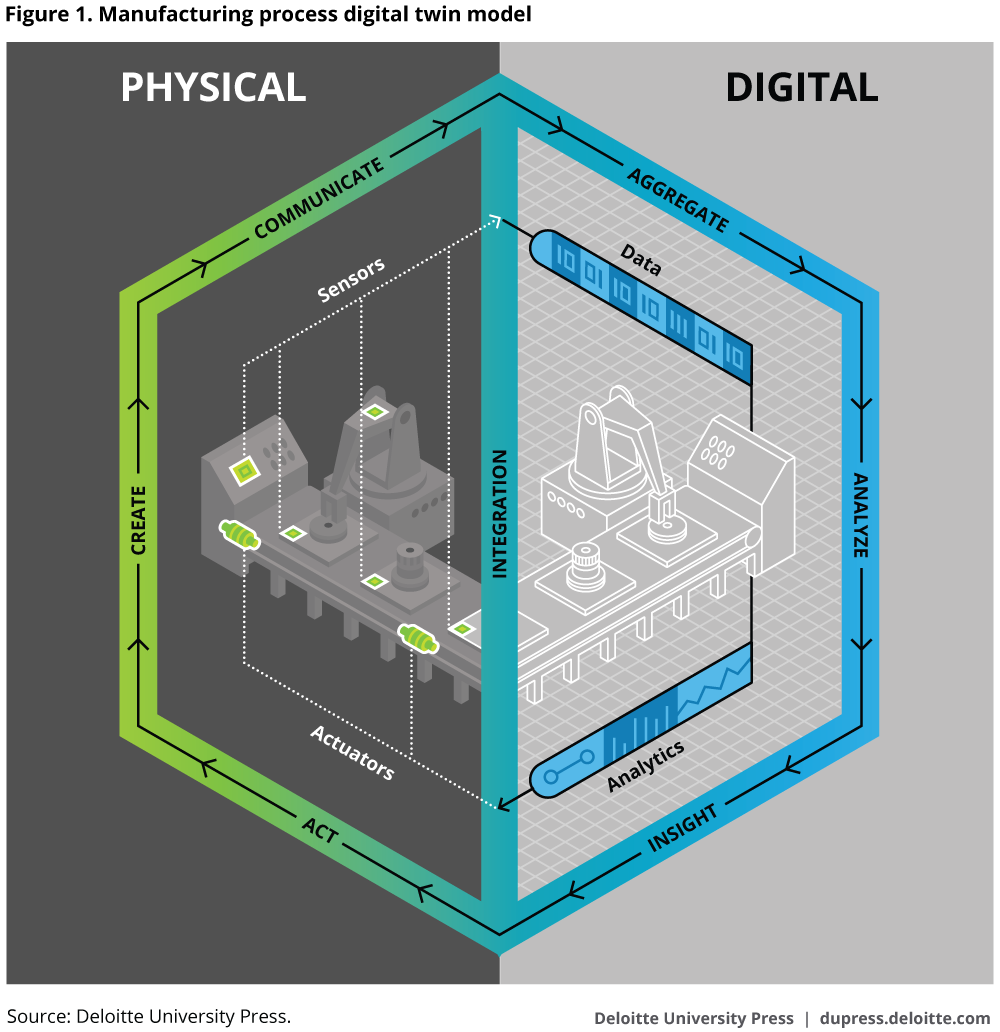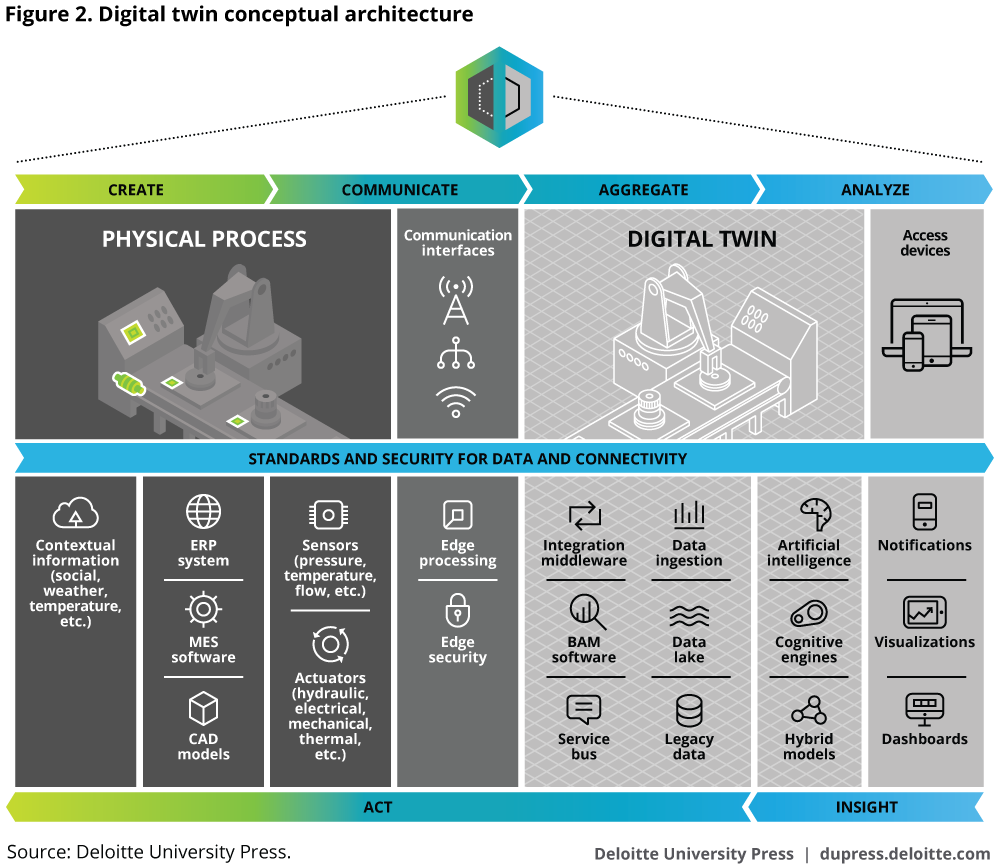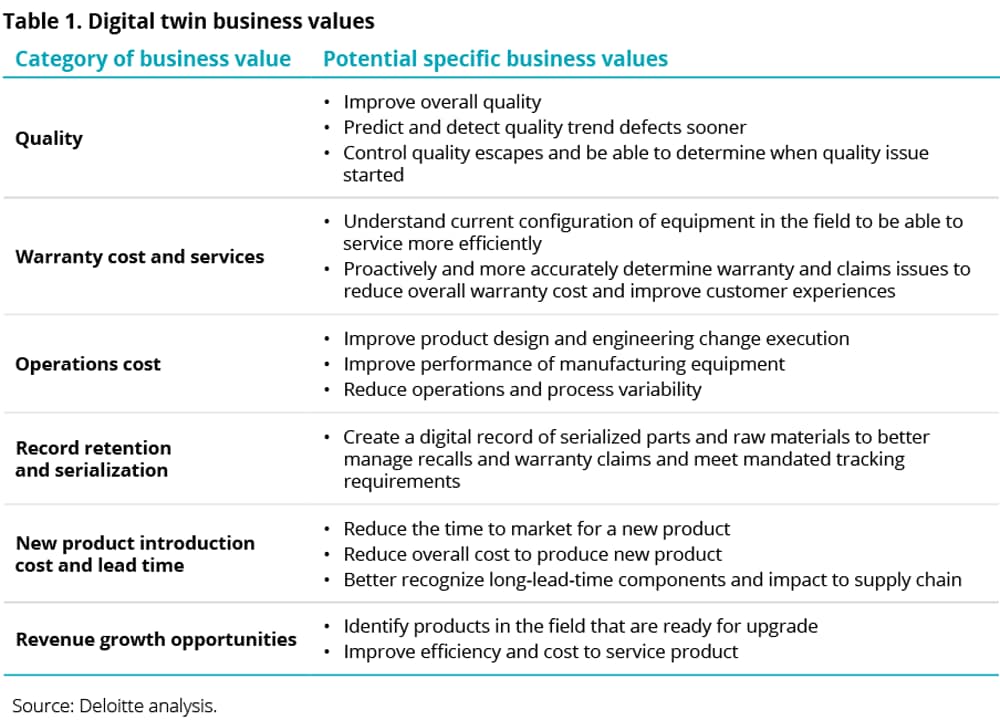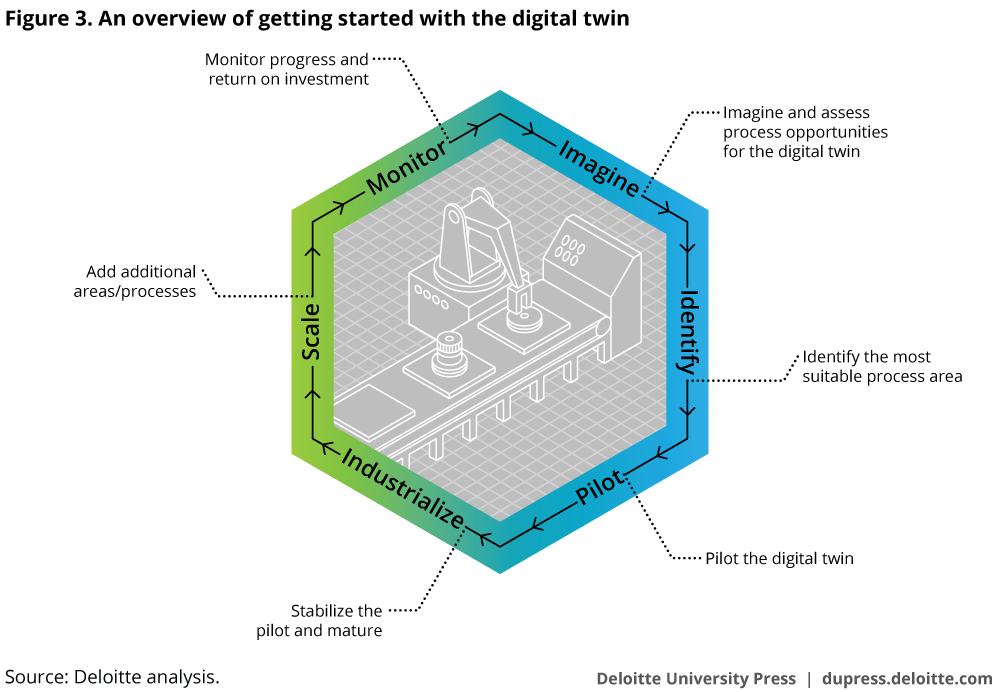Industry 4.0 and the digital twin has been saved

Industry 4.0 and the digital twin Manufacturing meets its match
12 May 2017
As manufacturing processes become increasingly digital, the digital twin is now within reach. By providing companies with a complete digital footprint of products, the digital twin enables companies to detect physical issues sooner, predict outcomes more accurately, and build better products.
Introduction
Learn More
Explore the Industry 4.0 collection
Watch the related video
Listen to the related podcast
There can be no turning back. Manufacturing processes are becoming increasingly digital. As this trend unfolds, many companies often struggle to determine what they should be doing to drive and deliver real value both operationally and strategically. Indeed, digital solutions may promise significant value for an organization—value that could never have been realized prior to the advent of connected, smart technologies. Of particular fascination of late seems to be the notion of a digital twin: a near-real-time digital image of a physical object or process that helps optimize business performance.
Until recently, the digital twin—and the massive amounts of data it processes—often remained elusive to enterprises due to limitations in digital technology capabilities as well as prohibitive computing, storage, and bandwidth costs. Such obstacles, however, have diminished dramatically in recent years.1 Significantly lower costs and improved power and capabilities have led to exponential changes that can enable leaders to combine information technology (IT) and operations technology (OT) to enable the creation and use of a digital twin.2
So why is the digital twin so important, and why should organizations consider it? The digital twin can allow companies to have a complete digital footprint of their products from design and development through the end of the product life cycle. This, in turn, may enable them to understand not only the product as designed but also the system that built the product and how the product is used in the field. With the creation of the digital twin, companies may realize significant value in the areas of speed to market with a new product, improved operations, reduced defects, and emerging new business models to drive revenue.
The digital twin may enable companies to solve physical issues faster by detecting them sooner, predict outcomes to a much higher degree of accuracy, design and build better products, and, ultimately, better serve their customers. With this type of smart architecture design, companies may realize value and benefits iteratively and faster than ever before.
It can be a daunting task to create a digital twin if a company would like to try this all at once. The key could be to start in one area, deliver value there, and continue to develop. But before anything else, enterprises should first understand the definition of and approach to the development of the digital twin in order to avoid being overwhelmed. In the pages that follow, we discuss the digital twin—its definition, the way it can be created, how it could drive value, its typical applications in the real world, and how a company can prepare for the digital twin planning process.
Digital twin: What it is, and why it matters
Industry and academia define a digital twin in several different ways. However, perhaps neither group places the required emphasis on the process aspects of a digital twin. For example, according to some, a digital twin is an integrated model of an as-built product that is intended to reflect all manufacturing defects and be continually updated to include the wear and tear sustained while in use.3 Other widely circulated definitions describe the digital twin as a sensor-enabled digital model of a physical object that simulates the object in a live setting.4
A digital twin can be defined, fundamentally, as an evolving digital profile of the historical and current behavior of a physical object or process that helps optimize business performance. The digital twin is based on massive, cumulative, real-time, real-world data measurements across an array of dimensions. These measurements can create an evolving profile of the object or process in the digital world that may provide important insights on system performance, leading to actions in the physical world such as a change in product design or manufacturing process.
A digital twin differs from traditional computer-aided design (CAD), nor does it serve as merely another sensor-enabled Internet of Things (IoT) solution.5 It could be much more than either. CAD is completely encapsulated in a computer-simulated environment that has demonstrated moderate success in modeling complex environments;6 and more simple IoT systems measure things such as position and diagnostics for an entire component, but not interactions between components and the full life cycle processes.7
Indeed, the real power of a digital twin—and why it could matter so much—is that it can provide a near-real-time comprehensive linkage between the physical and digital worlds. It is likely because of this interactivity between the real and digital worlds of product or process that digital twins may promise richer models that yield more realistic and holistic measurements of unpredictability. And thanks to cheaper and more powerful computing capabilities, these interactive measurements can be analyzed with modern-day massive processing architectures and advanced algorithms for real-time predictive feedback and offline analysis. These can enable fundamental design and process changes that would almost certainly be unattainable through current methods.
A digital twin can be defined, fundamentally, as an evolving digital profile of the historical and current behavior of a physical object or process that helps optimize business performance.
A manufacturing process example
Digital twins are designed to model complicated assets or processes that interact in many ways with their environments for which it is difficult to predict outcomes over an entire product life cycle.8 Indeed, digital twins may be created in a wide variety of contexts to serve different objectives. For example, digital twins are sometimes used to simulate specific complex deployed assets such as jet engines and large mining trucks in order to monitor and evaluate wear and tear and specific kinds of stress as the asset is used in the field. Such digital twins may yield important insights that could affect future asset design. A digital twin of a wind farm may uncover insights into operational inefficiencies. Other examples of deployed asset-specific digital twins abound.9
As insightful as digital twins of specific deployed assets may be, the digital twin of the manufacturing process appears to offer an especially powerful and compelling application. Figure 1 represents a model of a manufacturing process in the physical world and its companion twin in the digital world. The digital twin serves as a virtual replica of what is actually happening on the factory floor in near-real time. Thousands of sensors distributed throughout the physical manufacturing process collectively capture data along a wide array of dimensions: from behavioral characteristics of the productive machinery and works in progress (thickness, color qualities, hardness, torque, speeds, and so on) to environmental conditions within the factory itself. These data are continuously communicated to and aggregated by the digital twin application.
As insightful as digital twins of specific deployed assets may be, the digital twin of the manufacturing process appears to offer an especially powerful and compelling application.
The digital twin application continuously analyzes incoming data streams. Over a period of time, the analyses may uncover unacceptable trends in the actual performance of the manufacturing process in a particular dimension when compared with an ideal range of tolerable performance. Such comparative insight could trigger investigation and a potential change to some aspect of the manufacturing process in the physical world.
This is the journey of interactivity between the physical and digital worlds, which figure 1 endeavors to convey. Such a journey underscores the profound potential of the digital twin: thousands of sensors taking continuous, nontrivial measurements that are streamed to a digital platform, which, in turn, performs near-real-time analysis to optimize a business process in a transparent manner.

The model of figure 1 specifically finds expression through five enabling components—sensors and actuators from the physical world, integration, data, analytics, and the continuously updated digital twin application. These constituent elements of figure 1 are explained at a high level below:
- Sensors—Sensors distributed throughout the manufacturing process create signals that enable the twin to capture operational and environmental data pertaining to the physical process in the real world.
- Data—Real-world operational and environmental data from the sensors are aggregated and combined with data from the enterprise, such as the bill of materials (BOM),10 enterprise systems, and design specifications. Data may also contain other items such as engineering drawings, connections to external data feeds, and customer complaint logs.
- Integration—Sensors communicate the data to the digital world through integration technology (which includes edge, communication interfaces, and security) between the physical world and the digital world, and vice versa.
- Analytics—Analytics techniques are used to analyze the data through algorithmic simulations and visualization routines that are used by the digital twin to produce insights.
- Digital twin—The “digital” side of figure 1 is the digital twin itself—an application that combines the components above into a near-real-time digital model of the physical world and process. The objective of a digital twin is to identify intolerable deviations from optimal conditions along any of the various dimensions. Such a deviation is a case for business optimization; either the twin has an error in the logic (hopefully not), or an opportunity for saving costs, improving quality, or achieving greater efficiencies has been identified. The resulting opportunity may result in an action back in the physical world.
- Actuators—Should an action be warranted in the real world, the digital twin produces the action by way of actuators, subject to human intervention, which trigger the physical process.11
Clearly, the world of a physical process (or object) and its digital twin analogue are vastly more complex than a single model or framework can depict. And, of course, the model of figure 1 is just one digital twin configuration that focuses on the manufacturing portion of the product life cycle.12 But what our model aims to show is the integrated, holistic, and iterative quality of the physical and digital world pairing. It is through that prism that one may begin the actual process that serves to create a digital twin.
The digital twin and the physical-digital-physical loop
The digital twin configuration of figure 1 represents a journey from the physical world to the digital world and back to the physical world. This physical-digital-physical journey, or loop, comprises the cornerstone of Deloitte’s approach to Industry 4.0. Sometimes called the “fourth industrial revolution,” Industry 4.0 broadly describes a digital manufacturing environment that combines advanced manufacturing techniques with the IoT to create not only an interconnected manufacturing enterprise but one that communicates, analyzes, and uses information to drive further intelligent action back in the physical world.
For more information, see Deloitte's collection of thought leadership on Industry 4.0.
Creating a digital twin
But how does one create a digital twin? In general, the creation of the digital twin encompasses two main areas of concern:
- Designing the digital twin processes and information requirements in the product life cycle—from the design of the asset to the field use and maintenance of the asset in the real world
- The creation of the enabling technology to integrate the physical asset and its digital twin for real-time flow of sensor data and operational and transactional information from the company’s core systems, as expressed in a conceptual architecture.
Digital twin process design and information requirements
The digital twin creation starts with process design. What are the processes and integration points for which the twin will be modeling? Standard process design techniques should be used to show how business processes, people enabling the processes, business applications, information, and physical assets interact. Diagrams are created that link the process flow to the applications, data needs, and the types of sensor information required to create the digital twin. The process design is augmented with attributes where cost, time, or asset efficiency could be improved. These typically form the base line assumptions from which the digital twin enhancements should begin.
Key to the digital twin is focus on the kinds of information that will be required across the life cycle of the asset under consideration. It is often important to structure the information in a reusable way. Toward that end, the creation of a canonical data model can be important. A canonical data model is a common, enterprise-standard data structure. It enables different systems and applications to connect and exchange enterprise information. A canonical structure can allow the various systems that integrate with the digital twin to communicate in a simple agreed upon format. Such, in turn, may reduce the amount of information that must be stored outside of the systems of record, may eliminate the need to manage large master data structures, and can allow a company to use the digital twin in multiple ways with more flexibility to continually update the digital twin as it is integrated with the enterprise, but not burdened by it.
Digital twin conceptual architecture
The digital twin conceptual architecture (figure 2) can rightly be thought of as an expansive or “under the hood” look at the enabling components that comprise the manufacturing process digital twin model of figure 1, although the same basic principles may likely apply in any digital twin configuration. The conceptual architecture may be best understood as a sequence of six steps, as follows:13

- Create: The create step encompasses outfitting the physical process with myriad sensors that measure critical inputs from the physical process and its surroundings. The measurements by the sensors can be broadly classified into two categories: (1) operational measurements pertaining to the physical performance criteria of the productive asset (including multiple works in progress), such as tensile strength, displacement, torque, and color uniformity; (2) environmental or external data affecting the operations of a physical asset, such as ambient temperature, barometric pressure, and moisture level. The measurements can be transformed into secured digital messages using encoders and then transmitted to the digital twin.
The signals from the sensors may be augmented with process-based information from systems such as the manufacturing execution systems, enterprise resource planning systems, CAD models, and supply chains systems. This would provide the digital twin with a wide range of continually updating data to be used as input for its analysis.
- Communicate: The communicate step helps the seamless, real-time, bidirectional integration/connectivity between the physical process and the digital platform. Network communication is one of the radical changes that have enabled the digital twin; it comprises three primary components:
- Edge processing: The edge interface connects sensors and process historians, processes signals and data from them near the source, and passes data along to the platform. This serves to translate proprietary protocols to more easily understood data formats as well as reduce network communication. Major advances in this area have eliminated many bottlenecks that have limited the viability of a digital twin in the past.
- Communication interfaces: Communication interfaces help transfer information from the sensor function to the integration function. Many options are needed in this area, given that the sensor producing the insight can, in theory, be placed at almost any location, depending on the digital twin configuration under consideration: inside a factory, in a home, in a mining operation, or in a parking lot, among myriad other locations.14
- Edge security: New sensor and communication capabilities have created new security issues, which are still developing. The most common security approaches are to use firewalls, application keys, encryption, and device certificates. The need for new solutions to safely enable digital twins will likely become more pressing as more and more assets become IP enabled.
- Aggregate: The aggregate step can support data ingestion into a data repository, processed and prepared for analytics. The data aggregation and processing may be done either on the premises or in the cloud. The technology domains that power data aggregation and processing have evolved tremendously over the last few years in ways that allow designers to create massively scalable architectures with greater agility and at a fraction of the cost in the past.15
- Analyze: In the analyze step, data is analyzed and visualized. Data scientists and analysts can utilize advanced analytics platforms and technologies to develop iterative models that generate insights and recommendations and guide decision making.16
- Insight: In the insight step, insights from the analytics are presented through dashboards with visualizations, highlighting unacceptable differences in the performance of the digital twin model and the physical world analogue in one or more dimensions, indicating areas that potentially need investigation and change.
- Act: The act step is where actionable insights from the previous steps can be fed back to the physical asset and digital process to achieve the impact of the digital twin. Insights pass through decoders and are then fed into the actuators on the asset process, which are responsible for movement or control mechanisms, or are updated in back-end systems that control supply chains and ordering behavior—all subject to human intervention.17 This interaction completes the closed loop connection between the physical world and the digital twin.
The digital twin application is usually written in the primary system language of the enterprise, which uses the above steps to model the physical asset and processes. In addition, throughout the process, standards and security measures may be applied for purposes of data management and interoperable connectivity.
The computation power of big data engines, the versatility of the analytics technologies, the massive and flexible storage possibilities of the aggregation area, and integration with canonical data allow the digital twin to model a much richer, less isolated environment than ever before. In turn, such developments may lead to a more sophisticated and realistic model, all with the potential of lower-cost software and hardware.
It is important to note that the above conceptual architecture should be designed for flexibility and scalability in terms of analytics, processing, the number of sensors and messages, etc. This can allow the architecture to evolve rapidly with the continual, and sometimes exponential, changes in the market.
The digital twin and the digital thread
Any meaningful discussion of the digital twin should likely also include a discussion of a closely related concept known as the “digital thread.” At its highest level, a digital thread is a continuous, seamless strand of data that connects each stage of the product life cycle from design, to build, to in-the-field usage. It provides, in effect, the channel through which data about the product travel. Such data—their storage, ready access, modeling, and analysis—are what create the ability to model production and drive efficient supply chain communications.
When one thinks about the digital twin, one may think of a “living” phenomenon—a model of a nonstatic product or process whose purpose is to optimize business performance. The digital thread, in large measure, enables the digital twin to fulfill such purpose by providing the kinds of data that the twin needs to perform its analyses. In that sense, the digital twin gets its “life,” in part, from the information that the digital thread provides. The insights of the digital twin, in turn, may cause a change in product design or manufacturing process to alter the digital thread for future iterations of the object under consideration.18
For more information on the digital thread, see 3D opportunity and the digital thread: Additive manufacturing ties it all together.
For a further introduction to the digital supply network, see The rise of the digital supply network: Industry 4.0 enables the digital transformation of supply chains.
Driving business value
A pressing concern for possibly any company that starts on the journey to digitization could be the clear ability to show benefits and realize value from its investment in creating a digital twin. How may this new approach lead to changes in the way a company will operate and conduct business that leads to measurable business value? In the past, the creation of digital twins was costly and of limited benefit. With the emergence of increasingly favorable storage and computing costs, the number of use cases and possibilities to enable a digital twin has greatly expanded, in turn driving business value.19
With the emergence of increasingly favorable storage and computing costs, the number of use cases and possibilities to enable a digital twin has greatly expanded, in turn driving business value.
When considering the business value that the digital twin offers, companies should focus on issues related to strategic performance and marketplace dynamics, including improved and longer-lasting product performance, faster design cycles, potential for new revenue streams, and better warranty cost management. These strategic issues, among others, can translate into specific applications that might afford broad business value that a digital twin may realize. Table 1 lists a summary of such values by category.

Besides the areas of business values mentioned above, a digital twin may help address many other key performance and efficiency metrics for a manufacturing company. Overall, the digital twin may offer many applications to drive value and start to fundamentally change how a company does business. Such value may be measured in tangible results that may be tracked back to key metrics for a business.
Use case: Development of a full-life-cycle digital twin
Much of the discussion thus far has focused on a digital twin model of the manufacturing process portion of the product life cycle. The manufacturing process represents but one digital twin configuration. Indeed, another viable vision for a broad digital twin use case is a product-based application over the product’s entire life cycle: from idea development to use. One such example involves an industrial manufacturer, facing numerous quality issues in the field, resulting in costly maintenance and high warranty liability. The manufacturer was attempting to determine the source of the issues that were adversely affecting customer confidence and brand image. These issues created additional stress on the manufacturer’s supply network and higher cost as it attempted to address the identified problem.
In the effort to address these issues, the engineering and supply network organizations pursued a digital twin approach that sought to solve quality problems and improve sustainable aftersales services related to the maintenance warranty. First, they decided to combine the “as-designed” BOM with all the analogous information produced from manufacturing, termed the “as-manufactured” BOM. To help differentiate between them, the as-designed BOM consisted of development and tested elements, while the as-manufactured BOM consisted of elements aggregated by equipment that was used to produce the product, including procured parts details and assembly details. These results allowed engineers to run analytics and provide insights in production variation that impacted quality. As a result, the team was able to deliver unexpected insights to improve the assembly process, reducing rework by 15–20 percent.
With information at hand from this partial digital twin effort, the aftersales department is planning to soon expand this use case to leverage the digital twin process to more efficiently use information from products in the field—the "as-maintained" BOM—to better understand how process variation impacts performance changes and improvements that should be addressed. The complete information obtained from the as-designed BOM, as-manufactured BOM, and as-maintained BOM creates a “cradle-to-grave” digital journey that allows for a new era of business opportunity, including asset availability management, spare parts inventory optimization, predictive maintenance, and services.
How to get started
Given the wide applications of the digital twin, how does one get started? A major challenge in undertaking a digital twin process can reside in determining the optimal level of detail in creating a digital twin model. While an overly simplistic model may not yield the value a digital twin promises, taking too fast and broad an approach can almost guarantee getting lost in the complexity of millions of sensors, hundreds of millions of signals the sensors produce, and the massive amount of technology to make sense of the model. Therefore, an approach that is either too simplistic or too complex could kill the momentum to move forward. Figure 3 offers a possible approach that falls somewhere in between.

Imagine the possibilities. The first step would be to imagine and shortlist a set of scenarios that could benefit from having a digital twin. The right scenario may be different for every organization and circumstance, but will likely have the following two key characteristics:
- The product or manufacturing process being considered is valuable enough for the enterprise to invest in building a digital twin.
- There are outstanding, unexplained process- or product-related issues that could potentially unlock value either for the customers or the enterprise.
After the shortlist of scenarios is created, each scenario would be assessed to identify pieces of the process that can provide quick wins by using a digital twin. We encourage a focused ideation session with members of operational, business, and technical leadership for expediting the assessment.
Identify the process. The next step would be to identify the pilot digital twin configuration that is both of the highest possible value and has the best chance of being successful. Consider operational, business, and organizational change management factors in identifying which configurations could be best candidates for the pilot. Focus on areas that have potential to scale across equipment, sites, or technologies. Companies may face challenges going too deep into a specific digital twin of a highly complex equipment or manufacturing process, while the ability to deploy broadly across the organization tends to drive the most value and support: Focus on going broad rather than deep.
Pilot a program. Consider moving quickly into a pilot program using iterative and agile cycles to accelerate learning, manage risk proactively, and maximize return on initial investments. The pilot can be a subset of business divisions, or products to limit scope, but with the ability to show value to the enterprise. As you move through the pilot, the implementation team should support adaptability and an open mind-set—at any time of your journey, maintain an open and agnostic ecosystem that would allow adaptability and integration with new data (structured and unstructured) and leverage new technologies or partners. While you should want to be agnostic to any type of data sources (for example, new sensors and external data sources), you also need a solution that can support the expansion of an end-to-end solution (from early development to after sales). As soon as the initial value is delivered, consider building on this momentum to continue the drive for greater results. Communicate the value realized to the larger enterprise.
Industrialize the process. Once success is shown in the field, you can industrialize the digital twin development and deployment process using established tools, techniques, and playbooks. Manage expectations from the pilot team and other projects seeking to adopt it. Develop insights on the digital twin process and publish to the larger enterprise. This may include moving from a more siloed implementation to integration into the enterprise, implementation of a data lake, performance and throughput enhancements, improved governance and data standards, and implementation of organizational changes to support the digital twin.
Scale the twin. Once successful, it can be important to identify opportunities to scale the digital twin. Target adjacent processes and processes that have interconnections with the pilot. Use the lessons learned from the pilot and the tools, techniques, and playbooks developed during the pilot to scale expeditiously. As you scale, continue to communicate the value realized through the adoption of the digital twin to the larger enterprise and shareholders.
Monitor and measure. Solutions should be monitored to objectively measure the value delivered through the digital twin. Identify whether there were tangible benefits in cycle time, yield throughput, quality, utilization, incidents, and cost per item, among others. Make changes to digital twin processes iteratively, and observe results to identify the best possible configuration.
Most importantly, this is not a project that should typically end once a benefit is identified, implemented, and measured. To continually differentiate in the market place, companies should plan to move through the cycle again in new areas of the business over time.
All in all, true success in achieving early milestones on a digital twin journey will likely rely on an ability to grow and sustain the digital twin initiative in a fashion that can demonstrate increasing value for the enterprise over time. To help ensure such an outcome, one may need to integrate digital technologies and the digital twin into the complete organizational structure—from R&D to sales—continuously leveraging digital twin insights to change how the company conducts business, makes decisions, and creates new revenue streams.
Conclusion
The digital twin may drive tangible value for companies, create new revenue streams, and help them answer key strategic questions. With new technology capabilities, flexibility, agility, and lower cost, companies may be able to start their journeys to create a digital twin with lower capital investment and shorter time to value than ever before. A digital twin has many applications across the life cycle of a product and may answer questions in real time that couldn’t be answered before, providing kinds of value considered nearly inconceivable just a few years ago. Perhaps the question is not whether one should get started, but where one should start to get the biggest value in the shortest amount of time, and how one can stay ahead of the competition. What will be the first step, and how will you get started? It can be an overwhelming task to get there, but the journey starts with a single step.
© 2021. See Terms of Use for more information.




